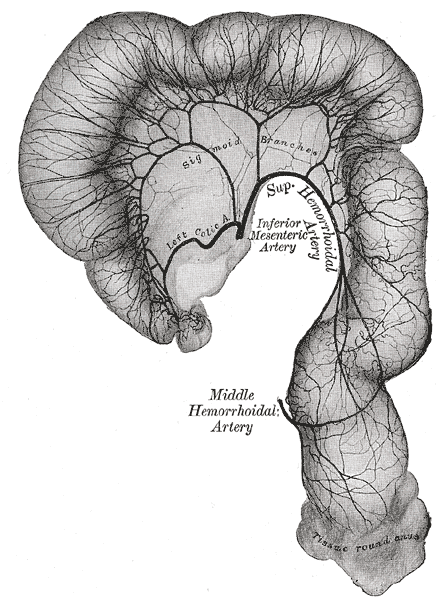Introduction
The inferior mesenteric artery (IMA) comes off the abdominal aorta a few inches below the takeoff of the superior mesenteric artery (SMA). The artery runs slightly lateral to the abdominal aorta after its origin at the level of the third lumbar vertebrae behind the third part of the duodenum. Embryologically, the inferior mesenteric artery supplies the area of the hindgut, the distal portions of the intestinal tract. The hindgut consists of the distal third of the transverse colon, descending colon, sigmoid colon, and superior segment of the rectum. The IMA classically terminates into three branches. These branches, from proximal to distal, include the left colic artery, the sigmoid artery, and the superior rectal artery. Straight arteries known as arcades carry blood from the branches of the IMA to the colon.[1][2][3][4]
The marginal artery of Drummond is a collateral pathway that connects the superior and inferior mesenteric arterial systems. The anastomotic network originates from the descending branch of the ileocolic artery, which is the most proximal branch of the SMA. The ileocolic artery connects with the right colic artery via the right colic's ascending and descending branches. This network is connected to the right and left branches of the middle colic artery, the ascending and descending branches of the left colic artery, and the sigmoid branches of the inferior mesenteric artery terminating in the superior rectal artery. The marginal artery often runs close to the bowel wall or within the mesentery. Less than half of the population has this collateral network fully complete around the splenic flexure (Griffith's point). This void of collaterals from the left branch of the middle colic artery to the ascending left colic artery can result in colonic ischemia in the setting of bowel surgery or occlusive disease.
There is further anastomosis via the arc of Riolan, also referred to as the meandering artery. If present, this pathway connects the SMAs middle colic artery with the IMAs left colic artery. This collateral supply is surgically relevant with regards to endovascular aneurysm repair. Collateralization via the arc of Riolan is an important pathway to permit coil embolization for type II endoleaks.[5]

